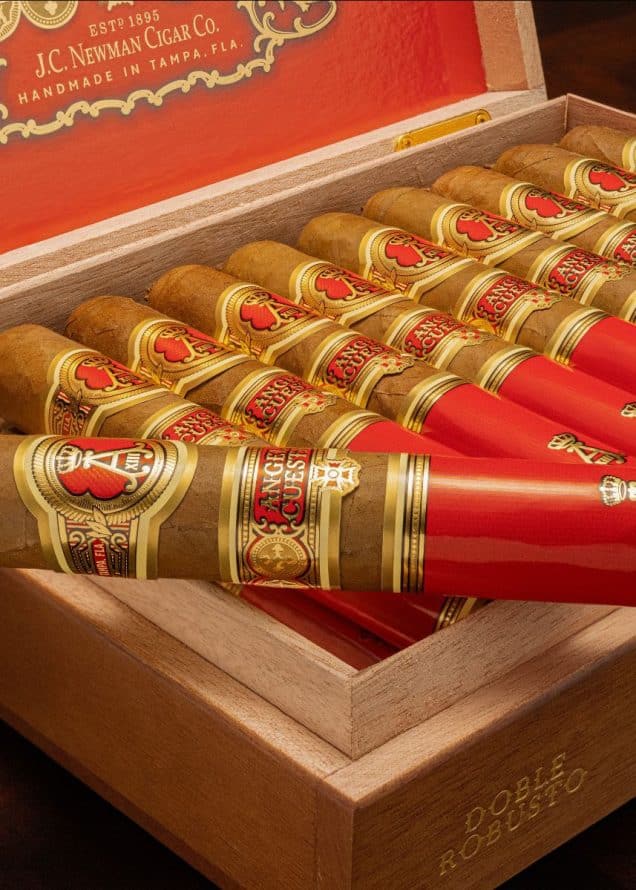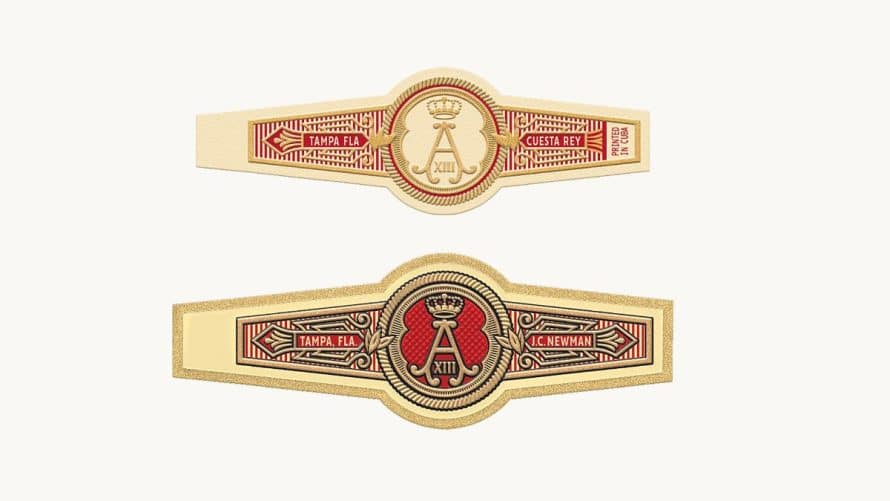After first showing off the cigars at the PCA trade show last year, J.C. Newman Cigar Co., is finally ready to launch Angel Cuesta Cigars. J.C. Newman showed off the final Angel Cuesta cigars at the Tobacconist Association of America meeting this week. These cigars were first sold a century ago and is named after Angel LaMadrid Cuesta, one of the founders of the storied Cuesta-Rey cigar brand. These cigars were the official cigar of King Alfonso XIII, who ruled Spain from 1886 to 1931.
Angel Cuesta cigars are rolled in The American Room at J.C. Newman‘s El Reloj cigar factory in Tampa, Florida. The blend uses an Ecuadorian Havana Rosado wrapper with binder and fillers from three continents. They are rolled in three sizes all with pigtail cap and come in cabinets of 20 cigars:
Angel Cuesta Doble Robusto – 5.5” x 56 MSRP $18.00
Angel Cuesta Doble Toro – 6.25” x 52 MSRP $19.00
Angel Cuesta Salomones – 7.25” x 57 MSRP $22.00
Only two rollers are producing Angel Cuesta cigars, and at a pace of 150 per day. Because of this, Angel Cuesta cigars are very limited. J.C. Newman released Angel Cuesta to 25 TAA members and expects to release these special cigars to additional premium cigar retailers across the United States twice a year. They are also available to those visiting J.C. Newman‘s Factory Store at its El Reloj cigar factory in Tampa.
Inside each box of Angel Cuesta cigars is the following excerpt of a story by Angel Cuesta on why Tampa was the Fine Cigar Capital of the World:
If you are a man who enjoys a really fine cigar, you have probably long since discovered the hand-made Tampa cigar with its superb smoking qualities – choice, clear Havana tobacco at its best! If you haven’t made this discovery, we believe it is time you did. And so we tell you how these cigars are created, and about Tampa, too – for the story of fine cigars is inseparable from the story of Tampa.
Angel LaMadrid Cuesta
Tampa today is the bustling metropolis of Florida’s West Coast, center of the most populous – and prosperous area of Florida. Despite the fact that it is the State’s leading industrial city, it is also a resort city – equally a fine place to work, to live, and to play. It is a city of color and contrasts; of carnival gaiety and progressive modern enterprise. Its Latin Quarter is a carry-over from the Old World into the new. In this Latin Quarter, center of life for some 40,000 persons of Spanish and Cuban descent, are located the majority of the cigar factories that produce these fine cigars.
The story of these cigars begins long ago. It begins in the mild, tropical climes of Cuban’s picturesque tobacco plantations. It begins in the skilled fingers of the cigarmaker, whose art is a heritage from the Old World. Yes, and it begins in the minds of a few enterprising men who had the foresight to recognize Tampa’s advantages as a potential cigar center.
It was Senor V. Martinez Ybor who pioneered the movement which made Tampa the cigar capital of America. In 1869 Ybor had transferred his factory from Havana to Key West, to escape the depredations of the Spanish volunteer troops. As others followed, Key West became the center of America’s clear Havana industry of America’s clear Havana industry.
Seventeen years later, Ybor and Eduardo Manrara, his partner, were impressed by the climatic and geographical possibilities of Tampa as a manufacturing site, when seeking a more favorable location for their operation. Tampa, then but a sprawling, lusty frontier hamlet, offered a large area of local hands to the cigar men, thus laying the cornerstone for one of the city’s principal industries. Other alert cigar men followed. Ybor’s example, and Tampa’s emergence as the manufacturing hub of Florida became an accomplished fact.
Today, the finest cigars in the world are made in Tampa
April 1948








